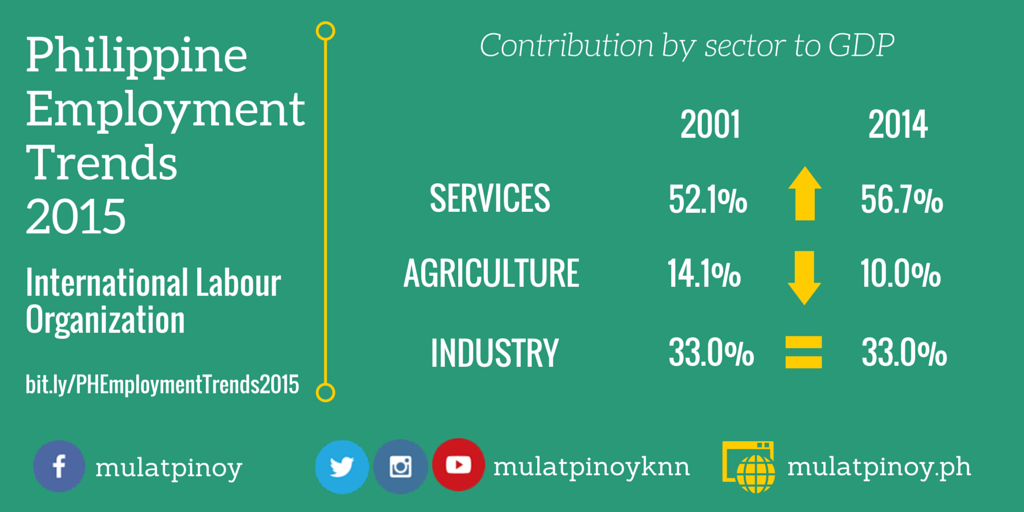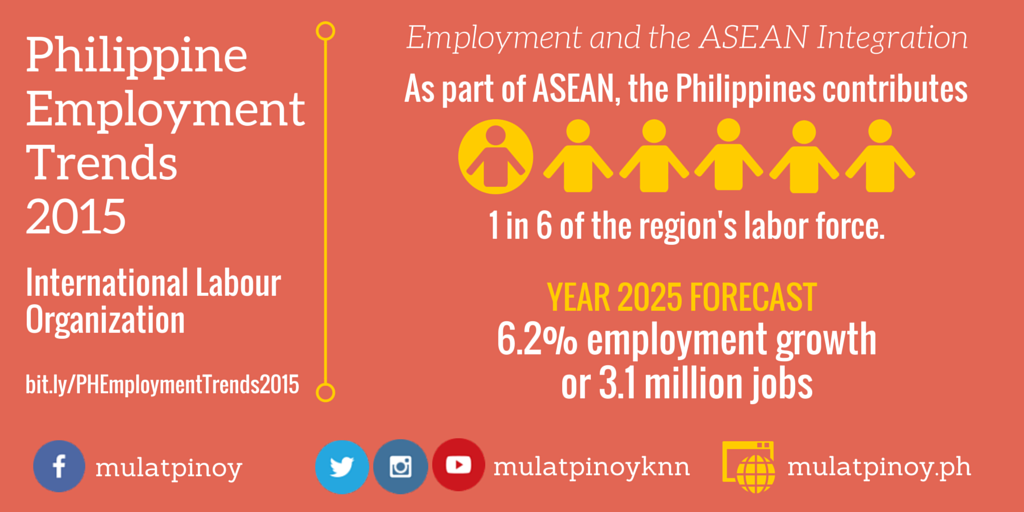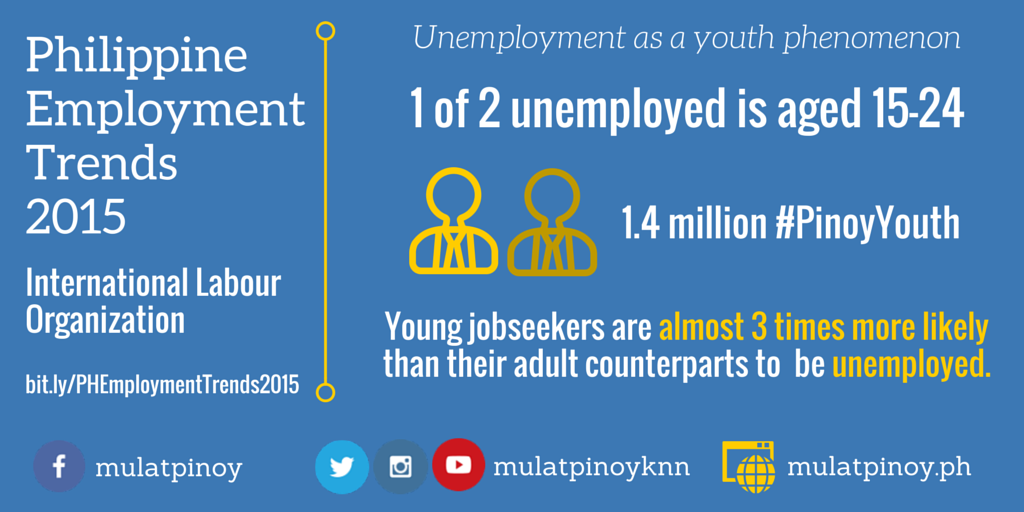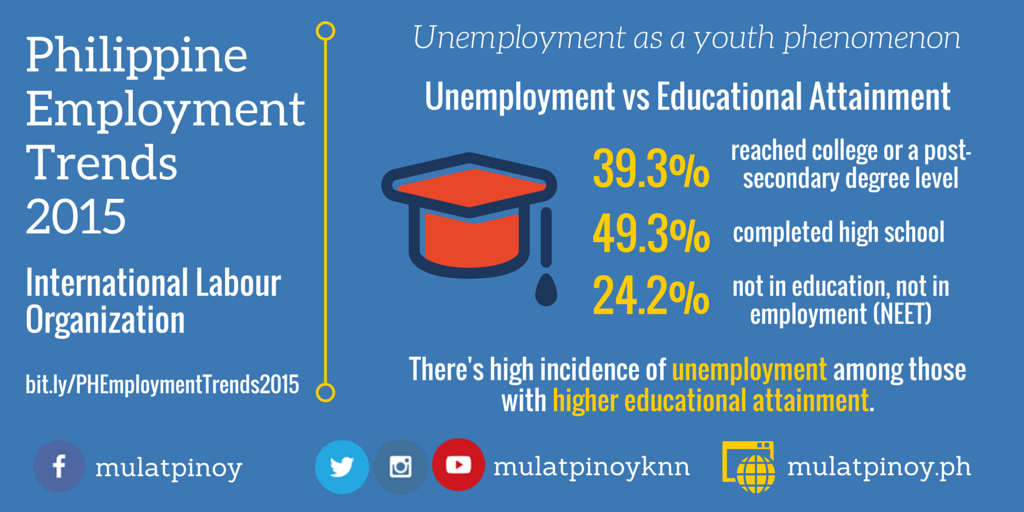A few days before Labor Day this year, the International Labour Organization (ILO) country office released its Philippine Employment Trends 2015 report, a document that summarizes how labor factors in the growth of the country. Data gathered shows that “the Philippine economy experienced robust rates of growth and made important gains in the labor market in recent years, however, more focus on decent and productive jobs is necessary to foster inclusive growth.”

ILO’s Philippine Employment Trends 2015 – Contribution by sector to GDP (Infographic by Rocel Ann G. Junio/MP-KNN)
The report then brings you macroeconomic data as well as trends in growth per sector and gender gap in employment. It is also very relevant as it factors in the impact of the ASEAN integration to the generation of jobs.

ILO’s Philippine Employment Trends 2015 – Employment and the ASEAN Integration (Infographic by Rocel Ann G. Junio/MP-KNN)
But what caught our attention is the section that explains how unemployment is primarily a youth phenomenon. To quote the report: “The unemployment challenge is primarily a youth phenomenon as 1.4 million young people account for almost one-half of the total unemployed. Despite some progress, the youth unemployment rate declined only slightly from 17.4% in 2008 to 16.1% in 2013. Young jobseekers are almost 3 times more like than their adult counterparts to be unemployed.”

ILO’s Philippine Employment Trends 2015 – Unemployment as a Youth Phenomenon (Infographic by Rocel Ann G. Junio/MP-KNN)
The report also points out that there’s a high incidence of unemployment among educated youth. While this might include young people who are still looking for jobs, it shows that educational attainment is no longer a guarantee to finding a good job. Or are we just producing more graduates but not enough jobs? And how about the underemployed, those who settled for jobs that are not related to the degree they finished? Where do they fall under?

ILO’s Philippine Employment Trends 2015 – Unemployment vs Educational Attainment (Infographic by Rocel Ann G. Junio/MP-KNN)
We have a great pool of talented #PinoyYouth who need opportunities to spend their energy and hone their skills. Let’s celebrate Labor Day for the hard-workers but reflect on how we can help our young jobseekers as well.
You may read ILO’s release below or take a look at the full report here.
Philippine Employment Trends 2015: Decent jobs crucial for inclusive growth
A new report published by the ILO shows that the Philippine economy experienced robust rates of growth and made important gains in the labour market in recent years, however, more focus on decent and productive jobs is necessary to foster inclusive growth.
MANILA – A new report published by the International Labour Organization (ILO) shows that the Philippine economy experienced robust rates of growth and made important gains in the labour market in recent years, however, more focus on decent and productive jobs is necessary to foster inclusive growth.
The ILO’s Philippine Employment Trends 2015 report finds relatively high economic growth rates of recent years, reaching 7.2 per cent in 2013 and 6.1 per cent in 2014.
The report also highlights that vulnerable employment, a measure of the quality of employment, declined from 43.5 per cent in 2008 to 38.3 per cent in 2013. Likewise, poverty rate among all Filipino workers saw a modest decline to 21.9 per cent in 2012 from 22.9 per cent in 2006.
Employment in the Philippines amounted to 38.1 million in 2013, a sizable increase of 4 million since 2008. The labour force also saw a faster growth since 2008 among women (13.6 per cent) compared to that of men (10.1 per cent).
Amidst robust economic growth and positive trends in the labour market, the Philippines was hit by major disasters and crises which have disrupted the local economy and affected key industries.
“These natural disasters and crises destroy jobs, livelihoods and other sources of income, and often reverse recent achievements and progress made at the individual, community and national levels. To build back better, it is crucial to put decent work and livelihoods at the forefront of recovery after the disaster,” said Lawrence Jeff Johnson, Director of the ILO Country Office for the Philippines.
Youth unemployment rate declined slightly from 17.4 per cent in 2008 to 16.1 per cent in 2013. However, 1.4 million young people account for one-half of the total unemployed and are almost three times more likely than their adult counterparts to be unemployed. The unemployment challenge is primarily a youth phenomenon, which includes those who are relatively educated in search of better options.
Decent employment remains a top priority in both the Philippines’ and international development agendas. Full and productive employment and decent work for all currently is proposed as a Post-2015 Sustainable Development Goal (SDG) by the United Nations.
The ILO report stresses that it is vital to ensure that growth translates into better labour market outcomes, including lower shares of vulnerable employment and working poverty.
“It is not the level of economic growth, but how we achieve growth with impact on people’s lives and the society,” said Johnson.
To support the creation of quality jobs and poverty reduction the report recommends:
- Facilitating a greater role of investment, including through better infrastructure and channelling of remittances.
- Mainstreaming productive employment in policy efforts such as the industry roadmaps.
- Investing in the development of relevant skills for the labour force in the Philippines.
- Strengthening the social protection framework to mitigate the adjustment costs of the structural changes that the economic development of the country requires.
- Enhancing the labour market information system to ensure policy decisions are informed and coherent.
For further information please contact:
Minette Rimando
Media and Public Information
ILO Country Office for the Philippines
Tel. No.:+63 2 580 9900 / 580 9905
Email
2 Comments on “1 of 2 Unemployed Filipinos is a #PinoyYouth, says ILO”
Great information being shared in this article. The infographic way of explaining the situation helps it to become much easier to understand.
What this article says is really true there are lots of you who are dropouts of school and unemployed, there are even some of our degree holders who are still looking for jobs that suitable for their degree.
I hope the government see this as a really serious problem and they would find better solution fast rather than forcing this K-12 program to be implemented that would even cause for another increase in unemployed and student dropouts.
-Nile
Hi Nile, thanks for your kind words! We do hope there’s a more systemic way of providing solutions to this, as we want our youth to be productive and make use of their talents while earning a living.